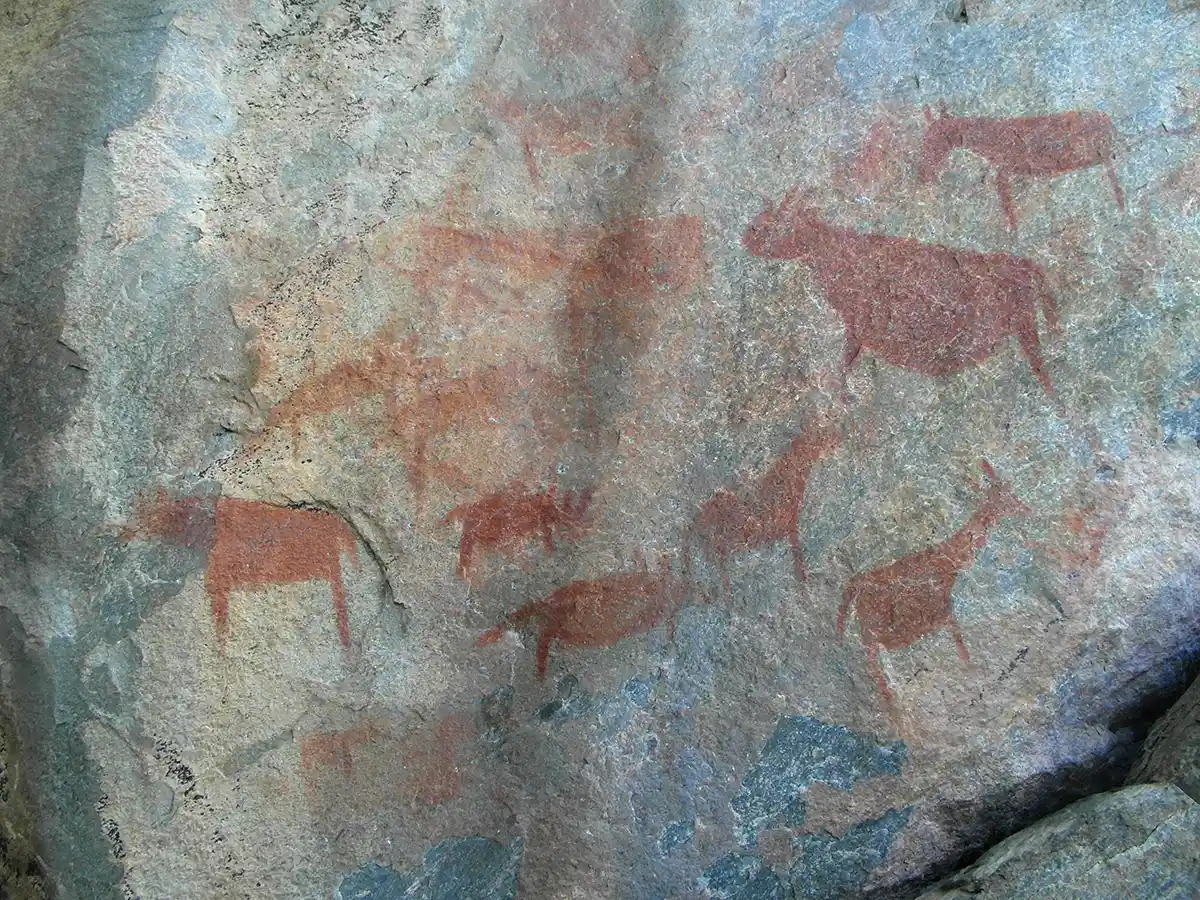Sacred Sites of Botswana
Botswana's landscape holds hidden layers of spiritual and cultural importance. From towering rock formations to ancient cave dwellings, here's a look at some of the most prominent sacred sites:
Tsodilo Hills Cave Paintings
The Tsodilo Hills (pictured above) stand as a beacon of ancient artistry and enduring beliefs. Designated a UNESCO World Heritage Site, the Tsodilo Hills are renowned for their extraordinary collection of over 4,500 rock paintings, showcasing the creative expressions and spiritual world of the San people, who have inhabited the region for thousands of years. These paintings offer a profound glimpse into their deep connection to nature, animals, and spiritual beliefs. The San still revere the Tsodilo Hills as the abode of ancestral spirits, where rituals bridge the realm of the living and the dead. Visitors to these hallowed hills can sense the enduring spiritual energy that permeates the landscape, evoking a deep reverence for the beliefs and heritage of the San.
Kubu Island
In the stark expanse of the Makgadikgadi salt pans, Kubu Island is a granite outlier rising like a lone sentinel. This granite rock island rises from the stark, flat landscape, holding historical and cultural importance for the local people. Archaeological findings suggest Kubu Island has been inhabited since the Stone Age. Traditionally a site of ancestral rituals, today it stands shielded by a special trust dedicated to safeguarding this fragile environment and protecting its sacred legacy against irresponsible tourism. Kubu Island, with its enigmatic presence and echoes of the past, offers a unique spiritual experience within Botswana's diverse landscape.
Kobokwe's Cave
Nestled in the Botswana Heritage Park, Kobokwe's Cave carries both a fascinating history and enduring spiritual significance. Local tradition paints this cave with tales of darkness, associating it with witchcraft and evil spirits. However, this perception shifted dramatically after famed missionary and explorer Dr. David Livingstone sought refuge within the cave and emerged unharmed. This pivotal event contributed to the conversion of many Batswana to Christianity. Today, Kobokwe's Cave (also known as Livingstone's Cave) has taken on a sacred aura for believers. It hosts regular midnight prayer meetings, transforming into a focal point of Christian pilgrimage within Botswana.
Matsieng Footprints
Situated in the eastern region of Botswana, the Matsieng Footprints bear witness to an ancient legend. Locals believe these impressions in the rock belong to Matsieng, a giant figure of ancestral importance, alongside the footprints of his animals. According to legend, Matsieng emerged from a hole in the ground after a great flood, shaping the world around him. Visitors to the site can follow a short walking trail to view the enigmatic footprints and connect with this enduring myth.
Domboshaba Ruins
In the northeastern part of Botswana, the Domboshaba Ruins serve as a testament to the once-flourishing Kalanga Kingdom. This stone-walled settlement dates back to the 14th century. While a great deal of mystery still surrounds the site, many Batswana revere it as a spiritually significant place linked to past power and ancestral spirits. Some claim Domboshaba was a site of sacred rituals, and traditional leaders seek blessings here before assuming ceremonial roles.
Old Palapye Ruins
Steeped in historical importance, Old Palapye Ruins mark the former capital of the Bangwato people. Built during the 19th century, this abandoned town still features crumbling walls, stone foundations, and the remnants of houses, churches, and kraals. While not explicitly regarded as 'sacred' in a traditional sense, Old Palapye Ruins carry a sense of reverence for many in Botswana. The site evokes a feeling of connection to the region's history and ancestors, and it inspires contemplation on the rise and fall of past civilizations.
Important Note: It's essential to recognize that while these sites hold immense significance, many sacred spaces in Botswana may remain unrecorded or known only to local communities. Indigenous knowledge and oral histories play a crucial role in understanding the deeper meanings of such places.

Martin Gray is a cultural anthropologist, writer and photographer specializing in the study of pilgrimage traditions and sacred sites around the world. During a 40 year period he has visited more than 2000 pilgrimage places in 160 countries. The World Pilgrimage Guide at sacredsites.com is the most comprehensive source of information on this subject.

